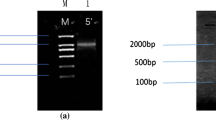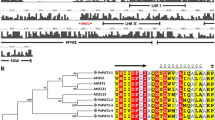Abstract
APETALA1 plays a crucial role in floral transition from vegetative to reproductive phase and in flower development. In this study, a comprehensive analysis of AP1 homologues in poplar was performed by describing the gene structure and chromosomal location. The phylogenetic relationship of the deduced amino acid sequences of Arabidopsis AP1 and AP1 homologues from Populus, to other AP1-like proteins was analyzed. The expression of PtAP1-1 and PtAP1-2 in Populus tomentosa was examined by RT-qPCR. Expression profiles were similar and both genes exhibited a high expression level in the reproductive phase. Seasonal expression profiles in floral buds indicated that the pattern of PtAP1-1 and PtAP1-2 expression in male and female floral buds was different. The trends of the PtAP1-1 and PtAP1-2 transcript levels in both sex floral buds were similar, but the peak of expression of the two genes in male buds was earlier than in female buds. This work would be of value to future functional analysis of AP1 homologues in poplar.



Similar content being viewed by others
References
Abe M et al (2005) FD, a bZIP protein mediating signals from the floral pathway integrator FT at the shoot apex. Science 309:1052–1056
An XM, Wang DM, Wang ZL, Wang JC, Cao GL, Bo WH, Zhang ZY (2010) Expression profile of PtLFY in floral bud development associated with floral bud morphological differentiation in Populus tomentosa. Sci Silvae Sin 46:32–38
An XM, Wang DM, Wang ZL, Li B, Bo WH, Cao GL, Zhang ZY (2011a) Isolation of a LEAFY homolog from Populus tomentosa: expression of PtLFY in P. tomentosa floral buds and PtLFY-IR-mediated gene silencing in tobacco (Nicotiana tabacum). Plant Cell Rep 30:89–100
An X, Ye M, Wang D, Wang Z, Cao G, Zheng H, Zhang Z (2011b) Ectopic expression of a poplar APETALA3-like gene in tobacco causes early flowering and fast growth. Biotechnol Lett 33:1239–1247
Arora R, Agarwal P, Ray S, Singh AK, Singh VP, Tyagi AK, Kapoor S (2007) MADS-box gene family in rice: genome-wide identification, organization and expression profiling during reproductive development and stress. BMC Genomics 8:242
Azeez A, Miskolczi P, Tylewicz S, Bhalerao RP (2014) A tree ortholog of APETALA1 mediates photoperiodic control of seasonal growth. Curr Biol 24:717–724
Berbel A, Navarro C, Ferrandiz C, Canas LA, Madueno F, Beltran JP (2001) Analysis of PEAM4, the pea AP1 functional homologue, supports a model for AP1-like genes controlling both floral meristem and floral organ identity in different plant species. Plant J 25:441–451
Böhlenius H, Huang T, Charbonnel-Campaa L, Brunner AM, Jansson S, Strauss SH, Nilsson O (2006) CO/FT regulatory module controls timing of flowering and seasonal growth cessation in trees. Science 312:1040–1043
Bradley D, Ratcliffe O, Vincent C, Carpenter R, Coen E (1997) Inflorescence commitment and architecture in Arabidopsis. Science 275:80–83
Calonje M, Cubas P, Martinez-Zapater JM, Carmona MJ (2004) Floral meristem identity genes are expressed during tendril development in grapevine. Plant Physiol 135:1491–1501
Chen Z et al (2013) A Novel Moderate Constitutive Promoter Derived from Poplar (Populus tomentosa Carriere). Int J Mol Sci 14:6187–6204
Chi Y, Huang F, Liu H, Yang S, Yu D (2011) An APETALA1-like gene of soybean regulates flowering time and specifies floral organs. J Plant Physiol 168:2251–2259
Corbesier L et al (2007) FT protein movement contributes to long-distance signaling in floral induction of Arabidopsis. Science 316:1030–1033
Davies B, Egea-Cortines M, de Andrade Silva E, Saedler H, Sommer H (1996) Multiple interactions amongst floral homeotic MADS box proteins. EMBO J 15:4330–4343
Egea-Cortines M, Saedler H, Sommer H (1999) Ternary complex formation between the MADS-box proteins SQUAMOSA, DEFICIENS and GLOBOSA is involved in the control of floral architecture in Antirrhinum majus. EMBO J 18:5370–5379
Elo A, Lemmetyinen J, Turunen ML, Tikka L, Sopanen T (2001) Three MADS-box genes similar to APETALA1 and FRUITFULL from silver birch (Betula pendula). Physiol Plantarum 112:95–103
Fernando DD, Zhang S (2006) Constitutive expression of the SAP1 gene from willow (Salix discolor) causes early flowering in Arabidopsis thaliana. Dev Genes Evol 216:19–28
Gasteiger E, Gattiker A, Hoogland C, Ivanyi I, Appel RD, Bairoch A (2003) ExPASy: the proteomics server for in-depth protein knowledge and analysis. Nucleic Acids Res 31:3784–3788
Goodstein DM et al (2012) Phytozome: a comparative platform for green plant genomics. Nucleic Acids Res 40:D1178–D1186
Hsu CY, Liu Y, Luthe DS, Yuceer C (2006) Poplar FT2 shortens the juvenile phase and promotes seasonal flowering. Plant Cell 18:1846–1861
Hsu CY et al (2011) FLOWERING LOCUS T duplication coordinates reproductive and vegetative growth in perennial poplar. Proc Natl Acad Sci USA 108:10756–10761
Hsu CY et al (2012) Overexpression of CONSTANS homologs CO1 and CO2 fails to alter normal reproductive onset and fall bud set in woody perennial poplar. PLoS One 7:e45448
Ingvarsson PK (2005) Nucleotide polymorphism and linkage disequilibrium within and among natural populations of European aspen (Populus tremula L., Salicaceae). Genetics 169:945–953
Jang S, An K, Lee S, An G (2002) Characterization of tobacco MADS-box genes involved in floral initiation. Plant Cell Physiol 43:230–238
Kagale S, Links MG, Rozwadowski K (2010) Genome-wide analysis of ethylene-responsive element binding factor-associated amphiphilic repression motif-containing transcriptional regulators in Arabidopsis. Plant Physiol 152:1109–1134
Kaufmann K et al (2010) Orchestration of floral initiation by APETALA1. Science 328:85–89
Kim S et al (2005) Expression of floral MADS-box genes in basal angiosperms: implications for the evolution of floral regulators. Plant J 43:724–744
Kotoda N, Wada M, Komori S, S-i Kidou, Abe K, Masuda T, Soejima J (2000) Expression pattern of homologues of floral meristem identity genes LFY and AP1 during flower development in apple. J Am Soc Hortic Sci 125:398–403
Kotoda N et al (2010) Molecular characterization of FLOWERING LOCUS T-like genes of apple (Malus × domestica Borkh.). Plant Cell Physiol 51:561–575
Leseberg CH, Li A, Kang H, Duvall M, Mao L (2006) Genome-wide analysis of the MADS-box gene family in Populus trichocarpa. Gene 378:84–94
Litt A, Irish VF (2003) Duplication and diversification in the APETALA1/FRUITFULL floral homeotic gene lineage: implications for the evolution of floral development. Genetics 165:821–833
Liu C, Xi W, Shen L, Tan C, Yu H (2009) Regulation of floral patterning by flowering time genes. Dev Cell 16:711–722
Livak KJ, Schmittgen TD (2001) Analysis of relative gene expression data using real-time quantitative PCR and the 2−ΔΔCt method. Methods 25:402–408
Mandel MA, Gustafson-Brown C, Savidge B, Yanofsky MF (1992) Molecular characterization of the Arabidopsis floral homeotic gene APETALA1. Nature 360:273–277
Mimida N et al (2011) Expression patterns of several floral genes during flower initiation in the apical buds of apple (Malus × domestica Borkh.) revealed by in situ hybridization. Plant Cell Rep 30:1485–1492
Mohamed R et al (2010) Populus CEN/TFL1 regulates first onset of flowering, axillary meristem identity and dormancy release in Populus. Plant J 62:674–688
Nishikawa F, Endo T, Shimada T, Fujii H, Shimizu T, Omura M, Ikoma Y (2007) Increased CiFT abundance in the stem correlates with floral induction by low temperature in Satsuma mandarin (Citrus unshiu Marc.). J Exp Bot 58:3915–3927
Nishikawa F, Endo T, Shimada T, Fujii H, Shimizu T, Omura M (2009) Differences in seasonal expression of flowering genes between deciduous trifoliate orange and evergreen Satsuma mandarin. Tree Physiol 29:921–926
Nishikawa F, Iwasaki M, Fukamachi H, Nonaka K, Imai A, Endo T (2011) Seasonal changes of citrus Flowering Locus T gene expression in kumquat. Bull Natl Inst Fruit Tree Sci 12:27–32
Parcy F, Bomblies K, Weigel D (2002) Interaction of LEAFY, AGAMOUS and TERMINAL FLOWER1 in maintaining floral meristem identity in Arabidopsis. Development 129:2519–2527
Pillitteri LJ, Lovatt CJ, Walling LL (2004) Isolation and Characterization of LEAFY and APETALA1 Homologues from Citrus sinensis L. Osbeck ‘Washington’. J Am Soc Hortic Sci 129:846–856
Ratcliffe OJ, Amaya I, Vincent CA, Rothstein S, Carpenter R, Coen ES, Bradley DJ (1998) A common mechanism controls the life cycle and architecture of plants. Development 125:1609–1615
Ratcliffe OJ, Bradley DJ, Coen ES (1999) Separation of shoot and floral identity in Arabidopsis. Development 126:1109–1120
Riechmann JL, Krizek BA, Meyerowitz EM (1996) Dimerization specificity of Arabidopsis MADS domain homeotic proteins APETALA1, APETALA3, PISTILLATA, and AGAMOUS. Proc Natl Acad Sci USA 93:4793–4798
Shchennikova AV, Shulga OA, Immink R, Skryabin KG, Angenent GC (2004) Identification and characterization of four chrysanthemum MADS-box genes, belonging to the APETALA1/FRUITFULL and SEPALLATA3 subfamilies. Plant Physiol 134:1632–1641
Shen L, Chen Y, Su X, Zhang S, Pan H, Huang M (2012) Two FT orthologs from Populus simonii Carrière induce early flowering in Arabidopsis and poplar trees. Plant Cell Tiss Organ Cult 108:371–379
Strauss SH, Rottmann WH, Brunner AM, Sheppard LA (1995) Genetic engineering of reproductive sterility in forest trees. Mol Breed 1:5–26
Strauss SH, Brunner AM, Busov VB, Ma C, Meilan R (2004) Ten lessons from 15 years of transgenic Populus research. Forestry 77:455–465
Tamura K, Peterson D, Peterson N, Stecher G, Nei M, Kumar S (2011) MEGA5: molecular evolutionary genetics analysis using maximum likelihood, evolutionary distance, and maximum parsimony methods. Mol Biol Evol 28:2731–2739
Tuskan GA et al (2006) The genome of black cottonwood, Populus trichocarpa (Torr. & Gray). Science 313:1596–1604
Wagner D, Sablowski RW, Meyerowitz EM (1999) Transcriptional activation of APETALA1 by LEAFY. Science 285:582–584
Wang J, Zhang X, Yan G, Zhou Y, Zhang K (2013) Over-expression of the PaAP1 gene from sweet cherry (Prunus avium L.) causes early flowering in Arabidopsis thaliana. J Plant Physiol 170:315–320
Weigel D, Meyerowitz EM (1994) The ABCs of floral homeotic genes. Cell 78:203–209
Wellmer F, Riechmann JL (2010) Gene networks controlling the initiation of flower development. Trends Genet 26:519–527
Wullschleger SD, Weston DJ, DiFazio SP, Tuskan GA (2012) Revisiting the sequencing of the first tree genome: Populus trichocarpa. Tree Physiol 33:357–364
Zhang L, Xu Y, Ma R (2008) Molecular cloning, identification, and chromosomal localization of two MADS box genes in peach (Prunus persica). J Genet Genomics 35:365–372
Zhang HL et al (2010) Precocious flowering in trees: the FLOWERING LOCUS T gene as a research and breeding tool in Populus. J Exp Bot 61:2549–2560
Acknowledgments
This work was supported by the National High Technology Research and Development Program of China (2011AA100201, 2013AA102703), the Project of National Natural Science Foundation of China (31170631, J1103516), the Changjiang Scholars and Innovative Research Team Program of China (IRT13047) and the Fundamental Research Funds for the Central Universities (BLYJ201410).
Conflict of interest
The authors declare that they have no conflict of interest.
Author information
Authors and Affiliations
Corresponding author
Additional information
Communicated by Y. Wang.
Electronic supplementary material
Below is the link to the electronic supplementary material.
11738_2015_1805_MOESM1_ESM.tif
Fig. S1 Schematic representation and physical location of the structure of AtAP1, PtrAP1-1 and PtrAP1-2 genes. a Schematic representation of the structure of AtAP1, PtrAP1-1 and PtrAP1-2 genes in Arabidopsis and poplar. Exons and untranslated regions (UTRs) are indicated as black and gray boxes, respectively, and lines between boxes indicate introns. b Physical locations of PtrAP1-1 and PtrAP1-2 genes on the genomic scaffolds (chromosomes). The scale bar represents 2.0 Mb. Scaffold numbers and sizes (Mb) are indicated below each scaffold (TIFF 425 kb)
Rights and permissions
About this article
Cite this article
Chen, Z., Yang, X., Su, X. et al. Identification and expression analysis of APETALA1 homologues in poplar. Acta Physiol Plant 37, 50 (2015). https://doi.org/10.1007/s11738-015-1805-z
Received:
Revised:
Accepted:
Published:
DOI: https://doi.org/10.1007/s11738-015-1805-z




